Porter’s Five Forces: Analyzing VR Technology in Civil Construction
VerifiedAdded on 2023/04/11
|10
|920
|186
Presentation
AI Summary
This presentation applies Porter's Five Forces to analyze the strategic value of virtual reality (VR) technology within the civil and building construction industry. It examines how VR impacts industry structure and competitiveness, considering factors like rivalry among existing firms, the threat of substitutes, the threat of new entrants, and the bargaining power of both suppliers and buyers. The presentation highlights the slow adoption of technology in the construction sector compared to other industries and discusses how VR can enhance various aspects of construction, from initial design to safety and project management. Furthermore, it touches upon other innovative technologies such as 3D printing, Building Information Modelling (BIM), AI, and digitization, and their influence on the industry's competitive landscape. The analysis also acknowledges the challenges and opportunities arising from labor shortages, rising project complexities, and the increasing demand for digital technologies in construction.
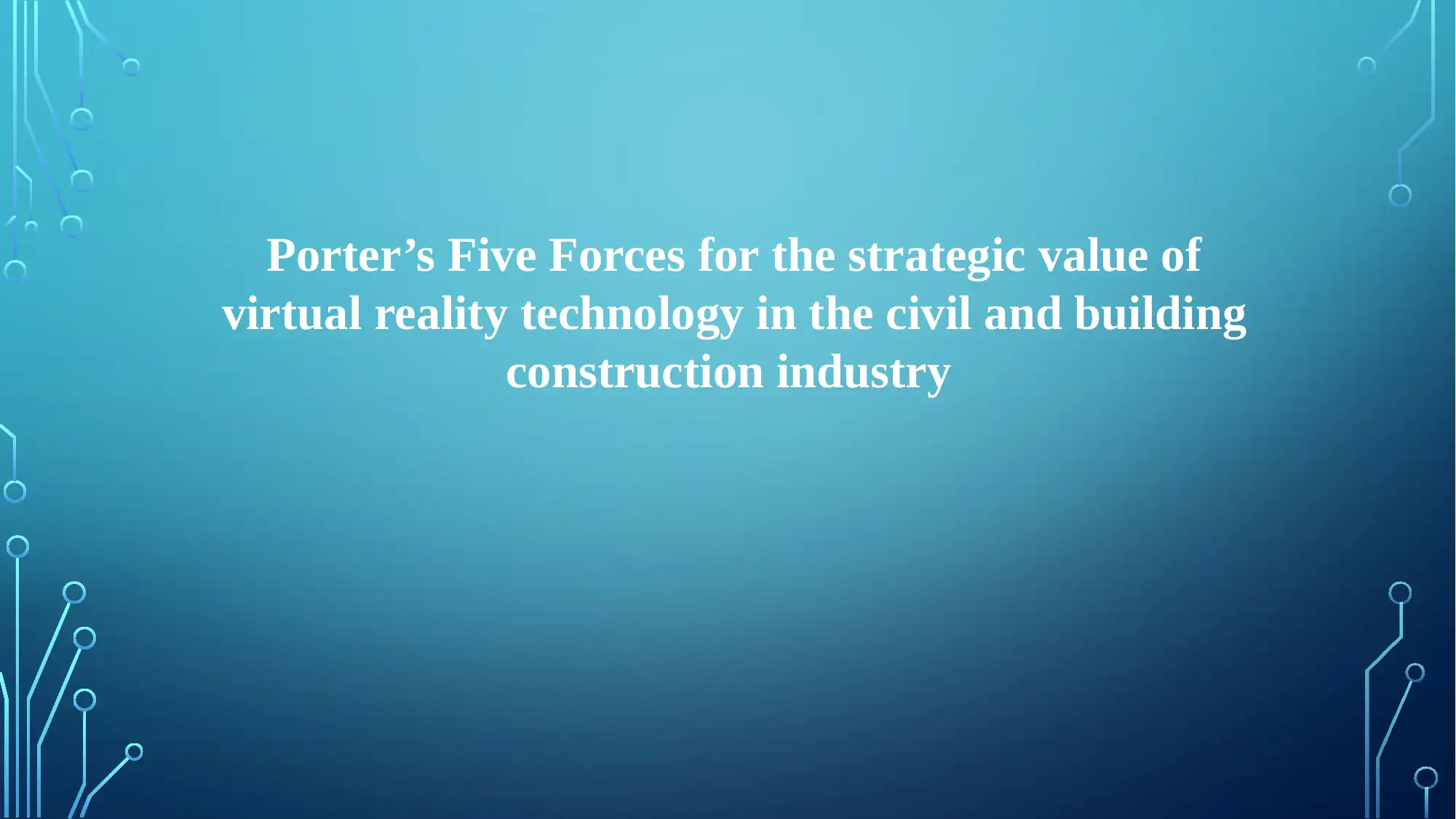
Porter’s Five Forces for the strategic value of
virtual reality technology in the civil and building
construction industry
virtual reality technology in the civil and building
construction industry
Paraphrase This Document
Need a fresh take? Get an instant paraphrase of this document with our AI Paraphraser
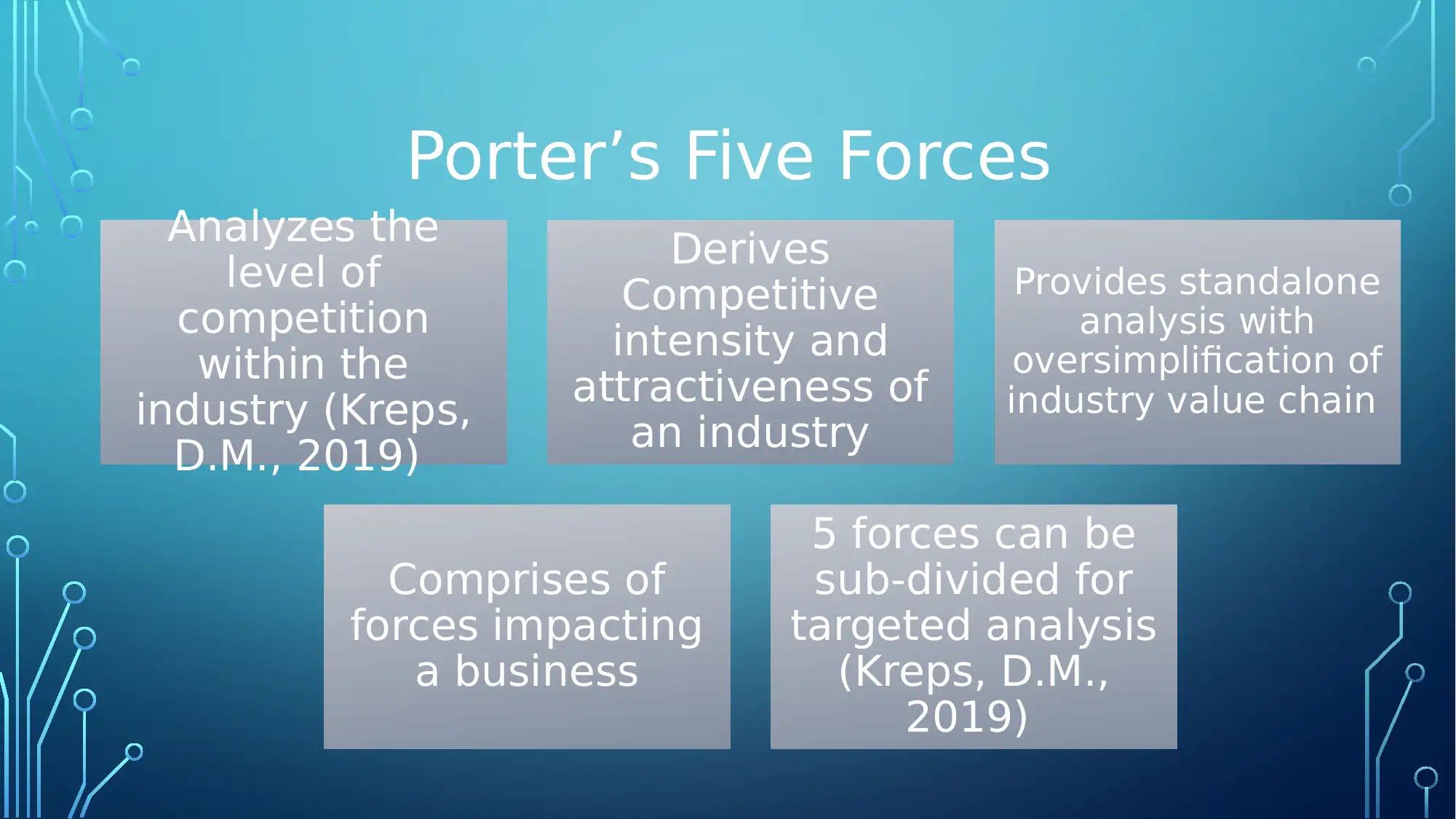
Porter’s Five Forces
Analyzes the
level of
competition
within the
industry (Kreps,
D.M., 2019)
Derives
Competitive
intensity and
attractiveness of
an industry
Provides standalone
analysis with
oversimplification of
industry value chain
Comprises of
forces impacting
a business
5 forces can be
sub-divided for
targeted analysis
(Kreps, D.M.,
2019)
Analyzes the
level of
competition
within the
industry (Kreps,
D.M., 2019)
Derives
Competitive
intensity and
attractiveness of
an industry
Provides standalone
analysis with
oversimplification of
industry value chain
Comprises of
forces impacting
a business
5 forces can be
sub-divided for
targeted analysis
(Kreps, D.M.,
2019)
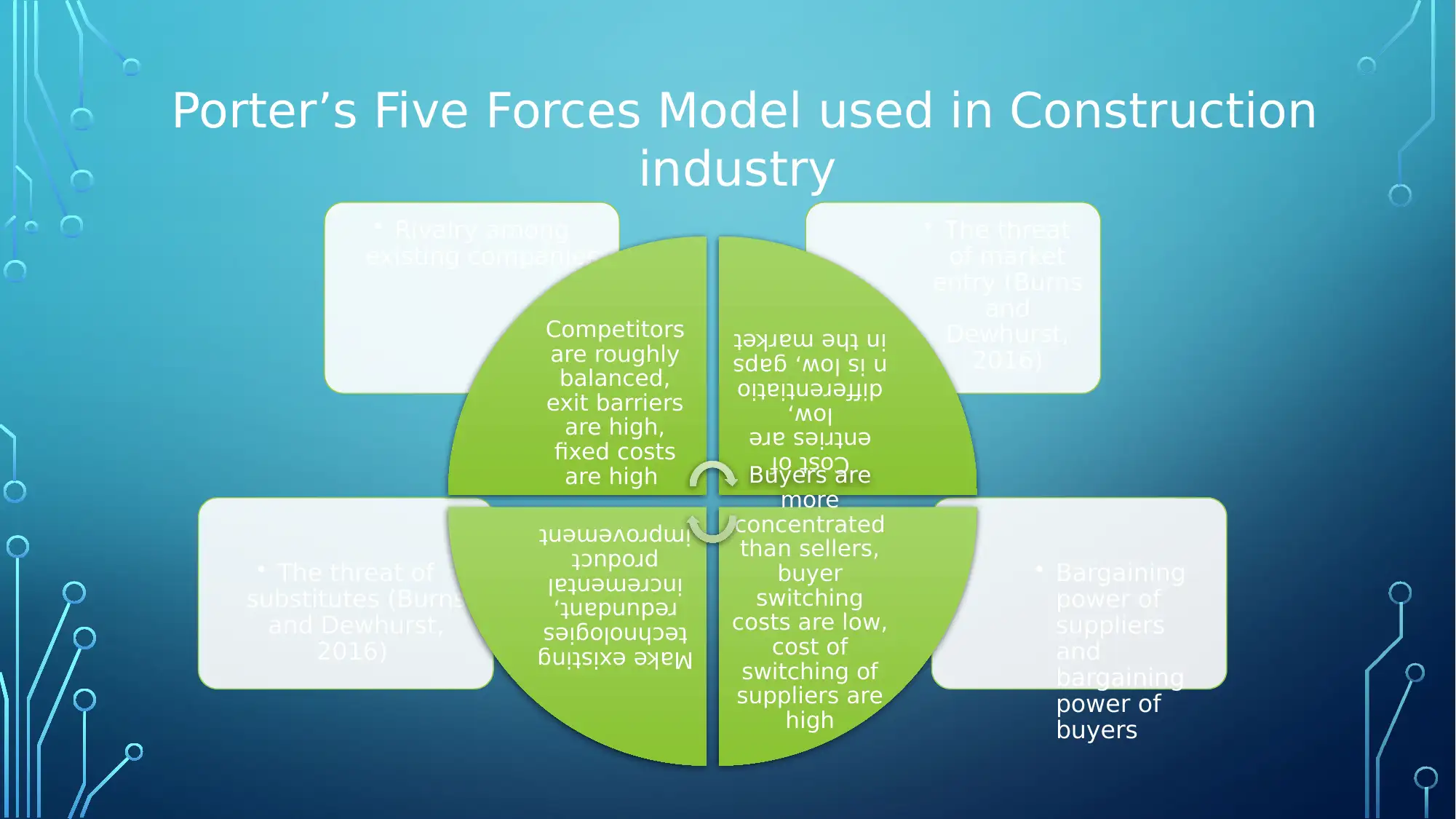
Porter’s Five Forces Model used in Construction
industry
• Bargaining
power of
suppliers
and
bargaining
power of
buyers
• The threat of
substitutes (Burns
and Dewhurst,
2016)
• The threat
of market
entry (Burns
and
Dewhurst,
2016)
• Rivalry among
existing companies
Competitors
are roughly
balanced,
exit barriers
are high,
fixed costs
are high
Cost of
entries are
low,
differentiatio
n is low, gaps
in the market
Buyers are
more
concentrated
than sellers,
buyer
switching
costs are low,
cost of
switching of
suppliers are
high
Make existing
technologies
redundant,
incremental
product
improvement
industry
• Bargaining
power of
suppliers
and
bargaining
power of
buyers
• The threat of
substitutes (Burns
and Dewhurst,
2016)
• The threat
of market
entry (Burns
and
Dewhurst,
2016)
• Rivalry among
existing companies
Competitors
are roughly
balanced,
exit barriers
are high,
fixed costs
are high
Cost of
entries are
low,
differentiatio
n is low, gaps
in the market
Buyers are
more
concentrated
than sellers,
buyer
switching
costs are low,
cost of
switching of
suppliers are
high
Make existing
technologies
redundant,
incremental
product
improvement
⊘ This is a preview!⊘
Do you want full access?
Subscribe today to unlock all pages.

Trusted by 1+ million students worldwide
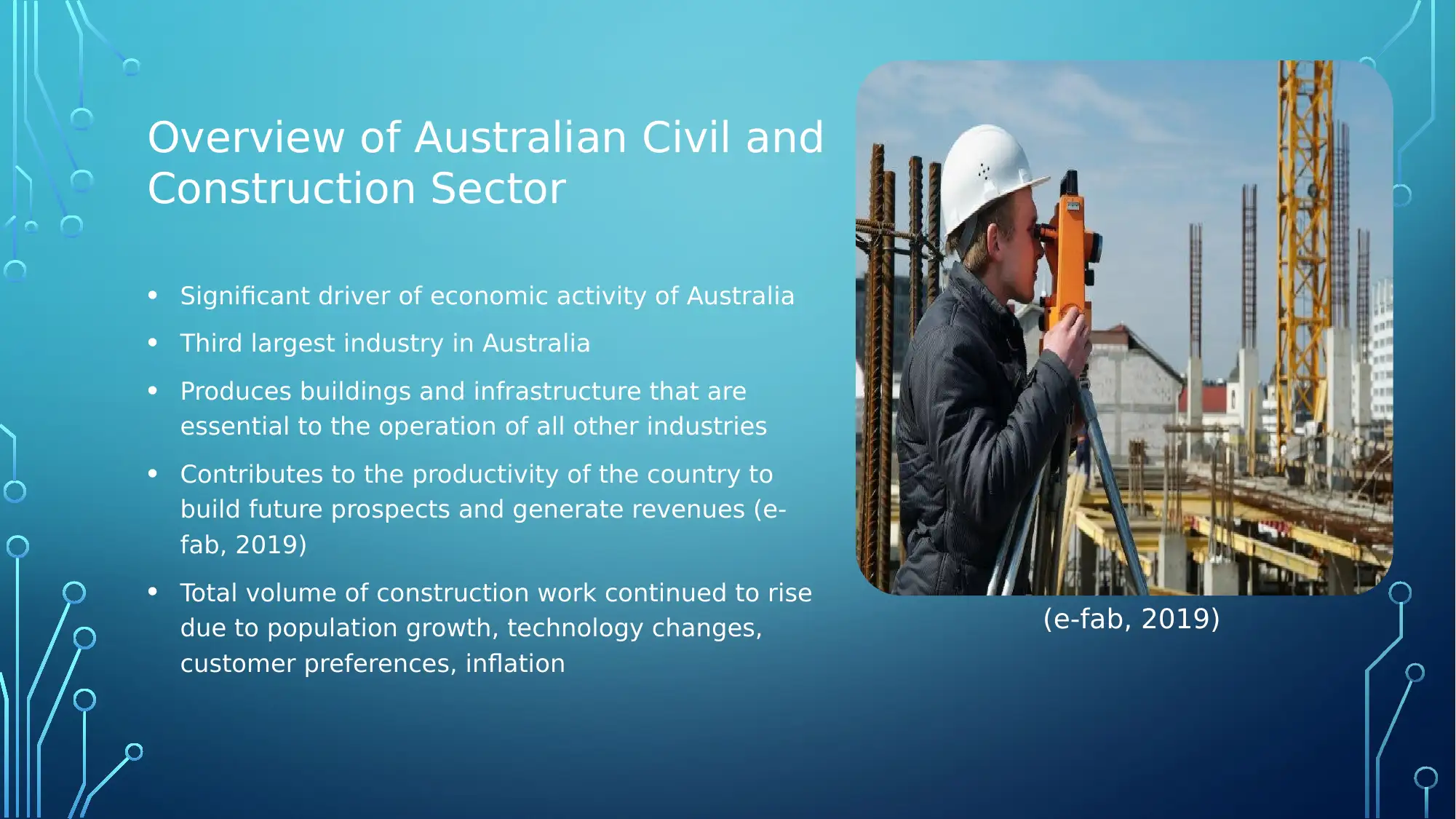
Overview of Australian Civil and
Construction Sector
• Significant driver of economic activity of Australia
• Third largest industry in Australia
• Produces buildings and infrastructure that are
essential to the operation of all other industries
• Contributes to the productivity of the country to
build future prospects and generate revenues (e-
fab, 2019)
• Total volume of construction work continued to rise
due to population growth, technology changes,
customer preferences, inflation
(e-fab, 2019)
Construction Sector
• Significant driver of economic activity of Australia
• Third largest industry in Australia
• Produces buildings and infrastructure that are
essential to the operation of all other industries
• Contributes to the productivity of the country to
build future prospects and generate revenues (e-
fab, 2019)
• Total volume of construction work continued to rise
due to population growth, technology changes,
customer preferences, inflation
(e-fab, 2019)
Paraphrase This Document
Need a fresh take? Get an instant paraphrase of this document with our AI Paraphraser
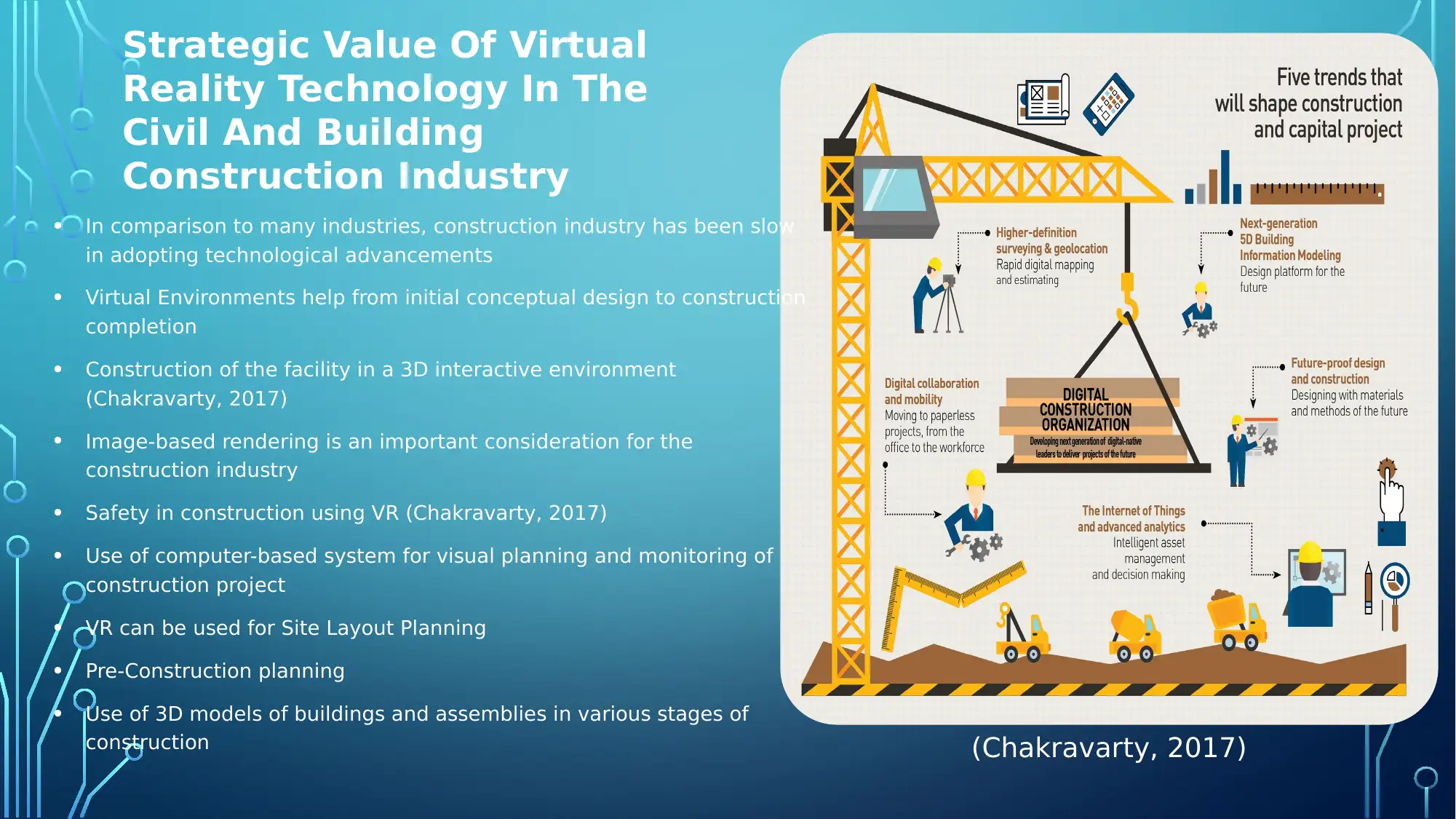
Strategic Value Of Virtual
Reality Technology In The
Civil And Building
Construction Industry
• In comparison to many industries, construction industry has been slow
in adopting technological advancements
• Virtual Environments help from initial conceptual design to construction
completion
• Construction of the facility in a 3D interactive environment
(Chakravarty, 2017)
• Image-based rendering is an important consideration for the
construction industry
• Safety in construction using VR (Chakravarty, 2017)
• Use of computer-based system for visual planning and monitoring of
construction project
• VR can be used for Site Layout Planning
• Pre-Construction planning
• Use of 3D models of buildings and assemblies in various stages of
construction (Chakravarty, 2017)
Reality Technology In The
Civil And Building
Construction Industry
• In comparison to many industries, construction industry has been slow
in adopting technological advancements
• Virtual Environments help from initial conceptual design to construction
completion
• Construction of the facility in a 3D interactive environment
(Chakravarty, 2017)
• Image-based rendering is an important consideration for the
construction industry
• Safety in construction using VR (Chakravarty, 2017)
• Use of computer-based system for visual planning and monitoring of
construction project
• VR can be used for Site Layout Planning
• Pre-Construction planning
• Use of 3D models of buildings and assemblies in various stages of
construction (Chakravarty, 2017)
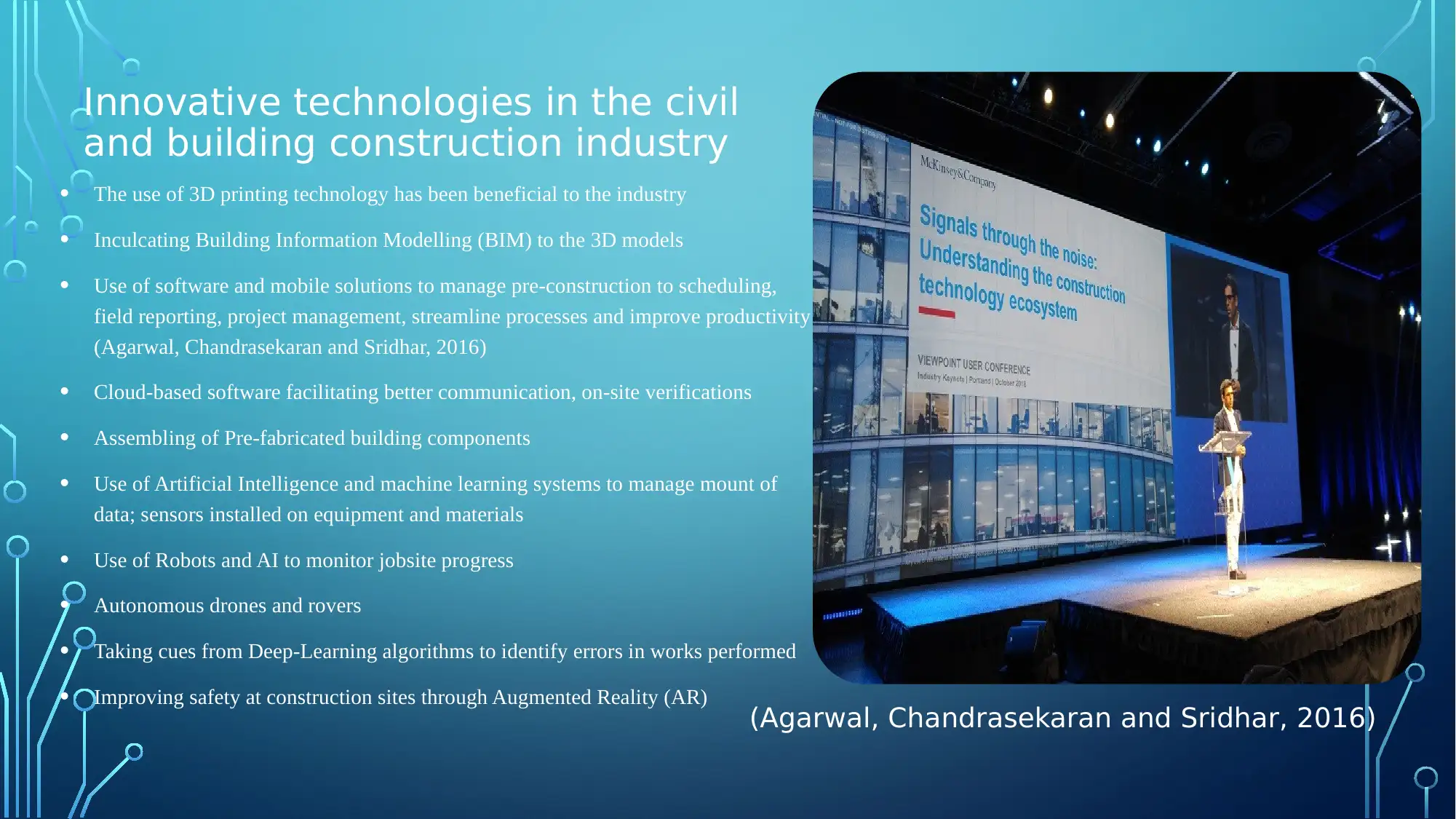
Innovative technologies in the civil
and building construction industry
• The use of 3D printing technology has been beneficial to the industry
• Inculcating Building Information Modelling (BIM) to the 3D models
• Use of software and mobile solutions to manage pre-construction to scheduling,
field reporting, project management, streamline processes and improve productivity
(Agarwal, Chandrasekaran and Sridhar, 2016)
• Cloud-based software facilitating better communication, on-site verifications
• Assembling of Pre-fabricated building components
• Use of Artificial Intelligence and machine learning systems to manage mount of
data; sensors installed on equipment and materials
• Use of Robots and AI to monitor jobsite progress
• Autonomous drones and rovers
• Taking cues from Deep-Learning algorithms to identify errors in works performed
• Improving safety at construction sites through Augmented Reality (AR)
(Agarwal, Chandrasekaran and Sridhar, 2016)
and building construction industry
• The use of 3D printing technology has been beneficial to the industry
• Inculcating Building Information Modelling (BIM) to the 3D models
• Use of software and mobile solutions to manage pre-construction to scheduling,
field reporting, project management, streamline processes and improve productivity
(Agarwal, Chandrasekaran and Sridhar, 2016)
• Cloud-based software facilitating better communication, on-site verifications
• Assembling of Pre-fabricated building components
• Use of Artificial Intelligence and machine learning systems to manage mount of
data; sensors installed on equipment and materials
• Use of Robots and AI to monitor jobsite progress
• Autonomous drones and rovers
• Taking cues from Deep-Learning algorithms to identify errors in works performed
• Improving safety at construction sites through Augmented Reality (AR)
(Agarwal, Chandrasekaran and Sridhar, 2016)
⊘ This is a preview!⊘
Do you want full access?
Subscribe today to unlock all pages.

Trusted by 1+ million students worldwide
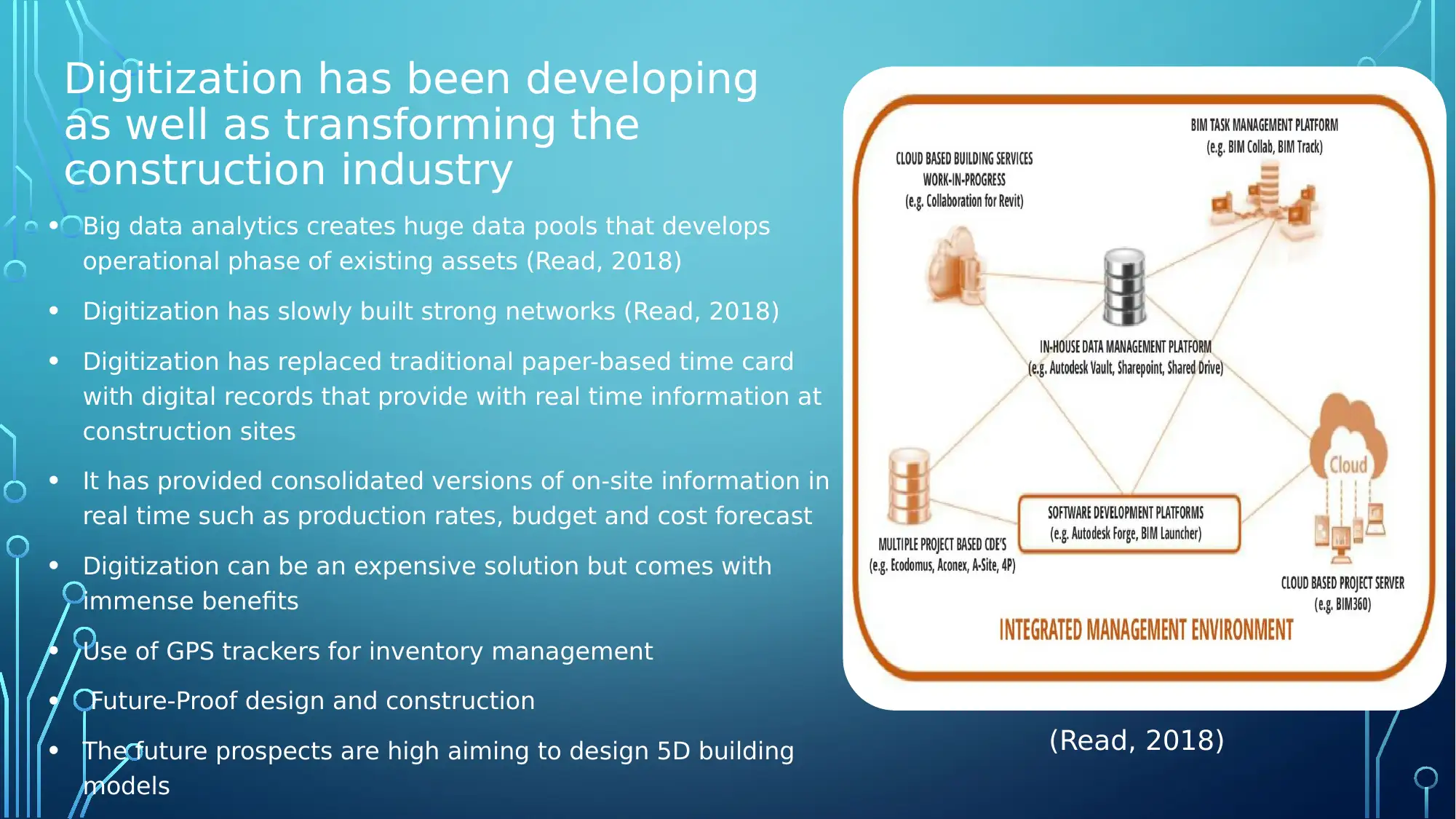
Digitization has been developing
as well as transforming the
construction industry
• Big data analytics creates huge data pools that develops
operational phase of existing assets (Read, 2018)
• Digitization has slowly built strong networks (Read, 2018)
• Digitization has replaced traditional paper-based time card
with digital records that provide with real time information at
construction sites
• It has provided consolidated versions of on-site information in
real time such as production rates, budget and cost forecast
• Digitization can be an expensive solution but comes with
immense benefits
• Use of GPS trackers for inventory management
• Future-Proof design and construction
• The future prospects are high aiming to design 5D building
models
(Read, 2018)
as well as transforming the
construction industry
• Big data analytics creates huge data pools that develops
operational phase of existing assets (Read, 2018)
• Digitization has slowly built strong networks (Read, 2018)
• Digitization has replaced traditional paper-based time card
with digital records that provide with real time information at
construction sites
• It has provided consolidated versions of on-site information in
real time such as production rates, budget and cost forecast
• Digitization can be an expensive solution but comes with
immense benefits
• Use of GPS trackers for inventory management
• Future-Proof design and construction
• The future prospects are high aiming to design 5D building
models
(Read, 2018)
Paraphrase This Document
Need a fresh take? Get an instant paraphrase of this document with our AI Paraphraser
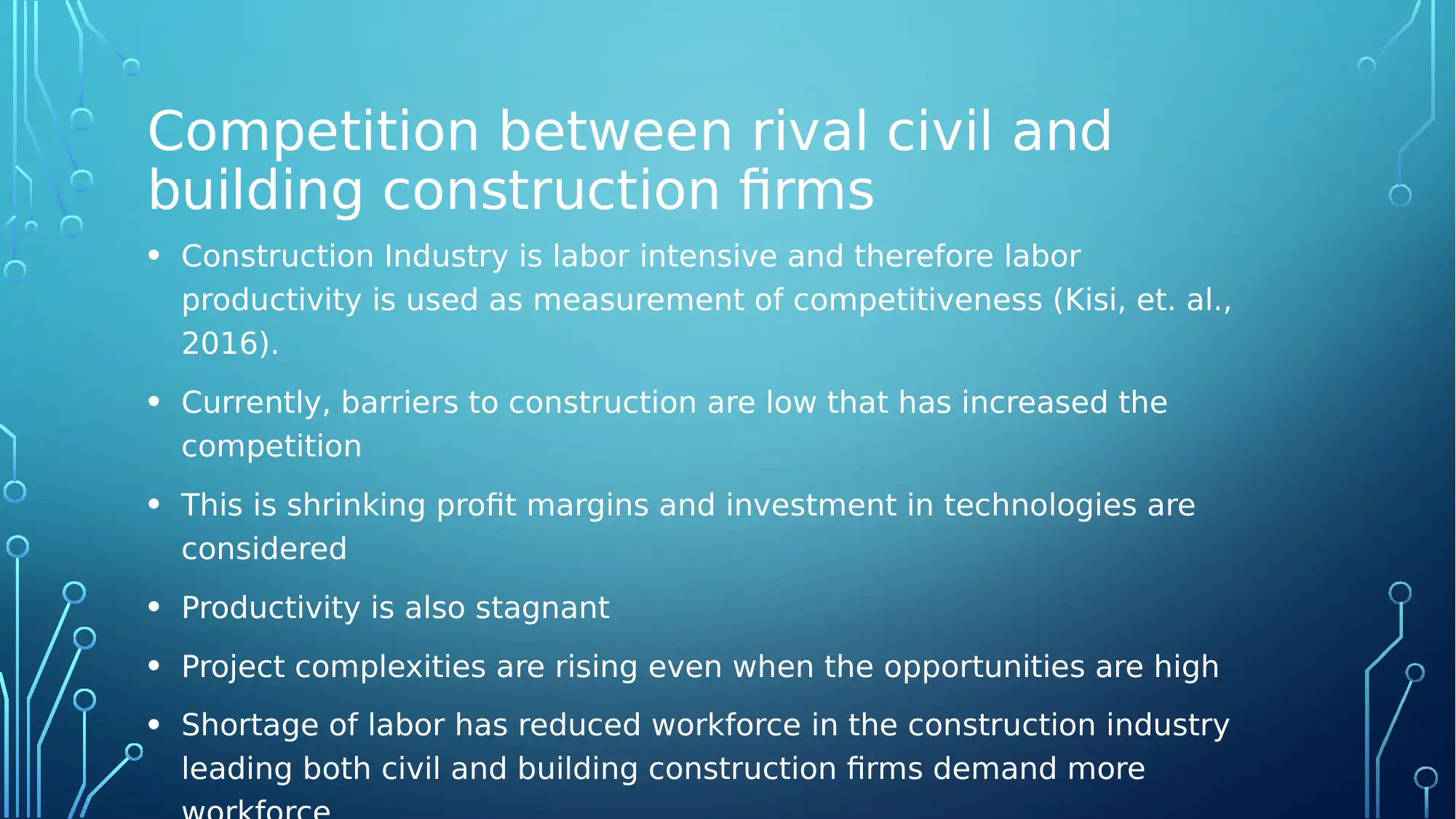
Competition between rival civil and
building construction firms
• Construction Industry is labor intensive and therefore labor
productivity is used as measurement of competitiveness (Kisi, et. al.,
2016).
• Currently, barriers to construction are low that has increased the
competition
• This is shrinking profit margins and investment in technologies are
considered
• Productivity is also stagnant
• Project complexities are rising even when the opportunities are high
• Shortage of labor has reduced workforce in the construction industry
leading both civil and building construction firms demand more
building construction firms
• Construction Industry is labor intensive and therefore labor
productivity is used as measurement of competitiveness (Kisi, et. al.,
2016).
• Currently, barriers to construction are low that has increased the
competition
• This is shrinking profit margins and investment in technologies are
considered
• Productivity is also stagnant
• Project complexities are rising even when the opportunities are high
• Shortage of labor has reduced workforce in the construction industry
leading both civil and building construction firms demand more
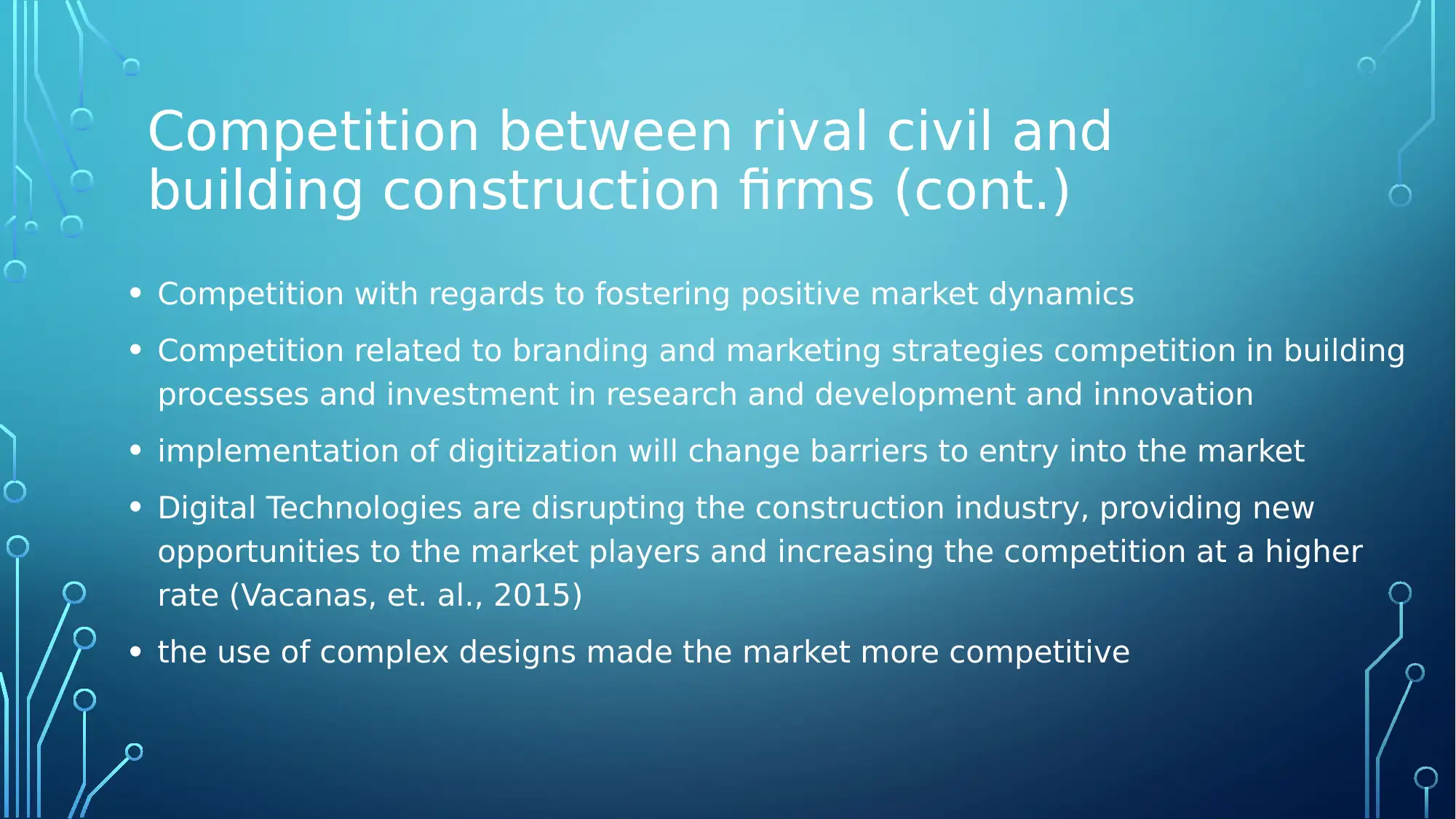
Competition between rival civil and
building construction firms (cont.)
• Competition with regards to fostering positive market dynamics
• Competition related to branding and marketing strategies competition in building
processes and investment in research and development and innovation
• implementation of digitization will change barriers to entry into the market
• Digital Technologies are disrupting the construction industry, providing new
opportunities to the market players and increasing the competition at a higher
rate (Vacanas, et. al., 2015)
• the use of complex designs made the market more competitive
building construction firms (cont.)
• Competition with regards to fostering positive market dynamics
• Competition related to branding and marketing strategies competition in building
processes and investment in research and development and innovation
• implementation of digitization will change barriers to entry into the market
• Digital Technologies are disrupting the construction industry, providing new
opportunities to the market players and increasing the competition at a higher
rate (Vacanas, et. al., 2015)
• the use of complex designs made the market more competitive
⊘ This is a preview!⊘
Do you want full access?
Subscribe today to unlock all pages.

Trusted by 1+ million students worldwide
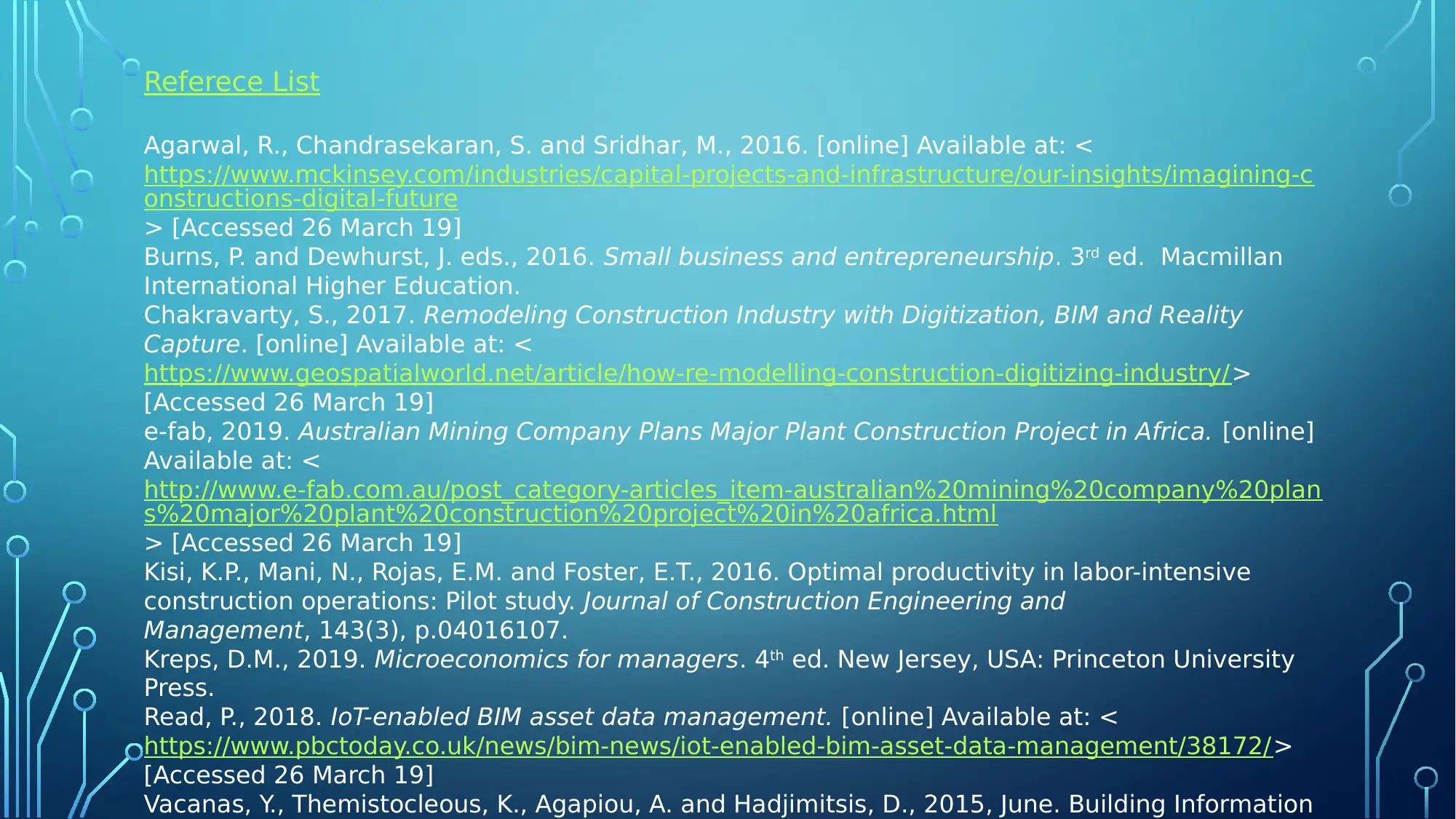
Referece List
Agarwal, R., Chandrasekaran, S. and Sridhar, M., 2016. [online] Available at: <
https://www.mckinsey.com/industries/capital-projects-and-infrastructure/our-insights/imagining-c
onstructions-digital-future
> [Accessed 26 March 19]
Burns, P. and Dewhurst, J. eds., 2016. Small business and entrepreneurship. 3rd ed. Macmillan
International Higher Education.
Chakravarty, S., 2017. Remodeling Construction Industry with Digitization, BIM and Reality
Capture. [online] Available at: <
https://www.geospatialworld.net/article/how-re-modelling-construction-digitizing-industry/>
[Accessed 26 March 19]
e-fab, 2019. Australian Mining Company Plans Major Plant Construction Project in Africa. [online]
Available at: <
http://www.e-fab.com.au/post_category-articles_item-australian%20mining%20company%20plan
s%20major%20plant%20construction%20project%20in%20africa.html
> [Accessed 26 March 19]
Kisi, K.P., Mani, N., Rojas, E.M. and Foster, E.T., 2016. Optimal productivity in labor-intensive
construction operations: Pilot study. Journal of Construction Engineering and
Management, 143(3), p.04016107.
Kreps, D.M., 2019. Microeconomics for managers. 4th ed. New Jersey, USA: Princeton University
Press.
Read, P., 2018. IoT-enabled BIM asset data management. [online] Available at: <
https://www.pbctoday.co.uk/news/bim-news/iot-enabled-bim-asset-data-management/38172/>
[Accessed 26 March 19]
Vacanas, Y., Themistocleous, K., Agapiou, A. and Hadjimitsis, D., 2015, June. Building Information
Agarwal, R., Chandrasekaran, S. and Sridhar, M., 2016. [online] Available at: <
https://www.mckinsey.com/industries/capital-projects-and-infrastructure/our-insights/imagining-c
onstructions-digital-future
> [Accessed 26 March 19]
Burns, P. and Dewhurst, J. eds., 2016. Small business and entrepreneurship. 3rd ed. Macmillan
International Higher Education.
Chakravarty, S., 2017. Remodeling Construction Industry with Digitization, BIM and Reality
Capture. [online] Available at: <
https://www.geospatialworld.net/article/how-re-modelling-construction-digitizing-industry/>
[Accessed 26 March 19]
e-fab, 2019. Australian Mining Company Plans Major Plant Construction Project in Africa. [online]
Available at: <
http://www.e-fab.com.au/post_category-articles_item-australian%20mining%20company%20plan
s%20major%20plant%20construction%20project%20in%20africa.html
> [Accessed 26 March 19]
Kisi, K.P., Mani, N., Rojas, E.M. and Foster, E.T., 2016. Optimal productivity in labor-intensive
construction operations: Pilot study. Journal of Construction Engineering and
Management, 143(3), p.04016107.
Kreps, D.M., 2019. Microeconomics for managers. 4th ed. New Jersey, USA: Princeton University
Press.
Read, P., 2018. IoT-enabled BIM asset data management. [online] Available at: <
https://www.pbctoday.co.uk/news/bim-news/iot-enabled-bim-asset-data-management/38172/>
[Accessed 26 March 19]
Vacanas, Y., Themistocleous, K., Agapiou, A. and Hadjimitsis, D., 2015, June. Building Information
1 out of 10
Your All-in-One AI-Powered Toolkit for Academic Success.
+13062052269
info@desklib.com
Available 24*7 on WhatsApp / Email
![[object Object]](/_next/static/media/star-bottom.7253800d.svg)
Unlock your academic potential
Copyright © 2020–2025 A2Z Services. All Rights Reserved. Developed and managed by ZUCOL.

